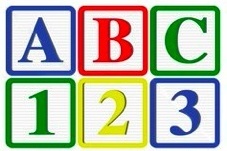 How often do you think about your ABC’s? Most likely, only when you need to sing that nursery rhyme in your head to remember if “J” comes before or after “K.” Then you’re stuck with that little earworm for the rest of the day.
How often do you think about your ABC’s? Most likely, only when you need to sing that nursery rhyme in your head to remember if “J” comes before or after “K.” Then you’re stuck with that little earworm for the rest of the day.
It turns out that knowing your ABC’s helps with a lot more than alphabetical filing. We’re talking about your health ABC’s – A1C, Blood Pressure, and Cholesterol. While knowing your credit score can keep you fiscally healthy, knowing your health numbers may keep you physically healthy. Here’s the cliff note version.
A is for A1C. This test provides an average measure of your blood sugars over the past three months. The typical life cycle of your red blood cells is approximately ninety days. To get an accurate picture of the amount of excess sugar in your blood stream, the A1C measures how much glucose has built up and attached to the protein in your red blood cells. Similar to adding sugar to water, the more sugar you add, the thicker it gets. The more “sludge” you have, the harder it is to move through the blood stream, so the sugar begins sticking to your red blood cells. Now it can be captured to determine your risk factor for diabetes.
- An A1c below 5.7 percent is considered normal.
- If your A1c measures between 5.7 – 6.4 percent think of it as your caution sign. Pre-diabetes is a risk factor for type 2 diabetes BUT you can take steps to delay it, or even prevent it.
- A level of 6.5 percent or above indicates diabetes. If you already have a diagnosis of diabetes, your goal is to keep your A1c between 6.5 – 7 percent.
- Greater than 7 percent is uncontrolled or poorly controlled diabetes and considered a serious chronic disease.
B is for blood pressure (BP). The top (systolic) number measures the pressure in the arteries when the heart beats. The bottom (diastolic) number measures the pressure in the arteries between heartbeats – when the heart muscle is resting and refilling with blood. A BP of less than 120/80 is within normal range.
Pre-hypertensive is when your systolic number is between 120-139, or diastolic number is between 80-89. Now is when your doctor may encourage you to make lifestyle changes like eating less salt, losing weight, and exercising more.
A BP range of 140-159 over 90-99 is considered stage I hypertension and a measurement of 160 or higher over 100 or higher stage II. Higher than 180 over 110 is a hypertensive crisis. (Danger! Danger! Emergency is care needed).
C is for cholesterol. Your cholesterol score is one of the factors your doctor can use to predict your risk of having a heart attack or stroke. Here’s the scoop on the good, the bad and the ugly cholesterol.
Good cholesterol helps reduce bad cholesterol levels. The American Heart Association recommends your HDL should be in the 60s range.
Bad cholesterol causes plaque to build up in your arteries putting you at risk for heart disease. An ideal LDL number should be less than 100 with your VLDL (aka very unhealthy cholesterol) lower than 30.
Triglycerides get the dubious honor of the ugly cholesterol category. High levels of this kind of fat are associated with coronary artery disease, especially in women. A triglyceride level of 100 or lower is considered optimal.
The moral of the story: On any given day, most of us know basketballs scores, FICA scores, and pin numbers, but don’t know the numbers that could save our lives.
If you know your ABC’s, thank your kindergarten teacher. If you don’t know your health ABC’s, ask your doctor.
